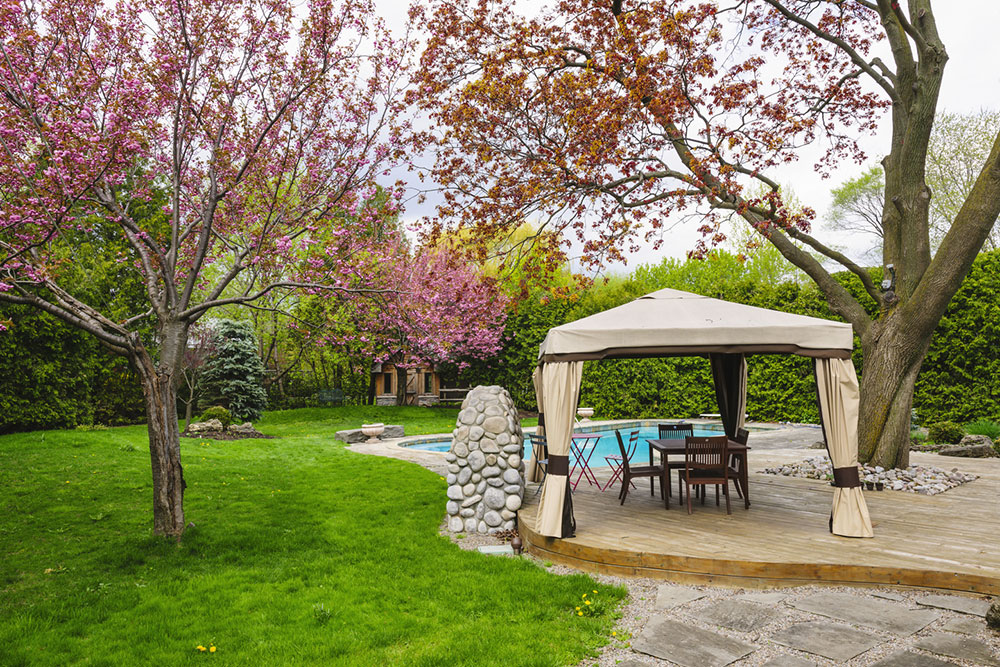12 patio or backyard shade ideas to protect from heat

Outdoor patio or backyard seating allows one to enjoy the natural ambiance and is often linked to better physical and mental well-being. There are many innovative ways to enhance one’s outdoor space, and an important element of it is shade. Whether hosting a barbecue or simply lounging with a cup of coffee, having a cool, shaded area is a must. Here are 12 heat shade ideas that combine functionality, affordability, and aesthetics.
1. Pergola
A popular type of shade, pergola is a versatile and visually appealing shaded structure used as a cover for walkways, passageways, or seating areas. It protects from the direct glare of the sun. One can use wood, metal, or vinyl climbing plants, bamboo, linen covers and shades, sheer curtains, and screens to shade the ground. The structure of a pergola is often supported by columns or posts, while the roof has crisscrossed grid patterns for shade.
2. Folding canopies
For flexibility and convenience, one can opt for foldable canopies. They are lightweight and quickly deployable structures and are ideal for instant shade at outdoor events, picnics, or casual gatherings. They come in various sizes and designs, offering an easy and versatile shading solution for different occasions.
3. Arbor
Arbor, which looks similar to a pergola, is a smaller version but does not usually have any columns or posts supporting it. It is freestanding and may be attached to fences. They are designed to give heat shade to smaller areas and also have holes that can bring in sufficient sunlight. The defining feature of an arbor is its lattice structure, which adds an element of dappled shade while maintaining an open and airy feel. This lattice provides a framework for climbing plants such as wisteria or vines, creating a beautiful and natural canopy that adds to the overall allure of the arbor.
4. Slatted overhang
The slatted overhang balances aesthetics and the practical need for shade. While it does not offer as much coverage as solid structures, slatted overhangs provide a touch of shade without being completely sheltered.
5. Cabana
For an alternative heat shade solution, a cabana serves as a portable shelter option. It looks like a gazebo and is found mostly near swimming pools or on the beach. This versatile structure provides a shaded retreat and can be easily transformed into a cozy hangout spot.
6. Reed mats
Reed mats are exactly what they say – simple structures that use interwoven reeds or bamboo placed on top as a shelter to keep things cool. Their straightforward design makes them an effective and natural solution for providing shade and maintaining a comfortable environment. If a pergola doesn’t meet one’s heat shade expectations, one can craft a DIY or personalized convertible canopy using reed mats. This introduces both functionality and stylistic texture to the seating area.
7. Triangle sun shade sail
Sun shade sails present a simple and versatile solution for blocking the sun. These lightweight canopies, featuring triangular-cut fabric with corner eyelets, can be easily attached to poles, the house’s side or nearby trees using sturdy twine or rope. Unlike traditional canopies, sun shade sails hang from poles and trees, offering adaptability in placement. Whether adjusting over a patio or smaller spaces, the triangular design caters to both functionality and a minimalist aesthetic.
8. Outdoor curtain hangings
Curtains are also another good option for a shadier patio experience. While they may not block overhead light entirely, these versatile drapes allow to control the amount of streaming light from the sides. One can adjust them as needed to create the desired ambiance.
9. Straw roof
One can consider unconventional shade solutions like a straw roof, a palm gazebo, or a thatched pergola top for a getaway feel. The textured aesthetics can turn one’s patio into a retreat.
10. Umbrella
A portable umbrella is another common outdoor-friendly cover that can create a shaded patch outdoors. They are easy to move around and can be versatile in terms of uses. They can be used near swimming pools, beds, seating areas, and more. They come in various sizes, which can help customize the outdoor shading.
11. Hanging gardens or shade-giving trees
A tree is said to lower the temperature by 20 degrees or more during hot days. So, one can combine greenery with shade by creating hanging gardens. Install shelves or use hanging pots to let vines and plants provide a natural canopy. In any yard, a lattice canopy adorned with lush vines can offer the desired shade alongside vibrant greenery. In contrast to traditional patio covers, the simplicity of this structure lies in several fast-growing smaller trees forming an ideal shade canopy.
12. Multi-layered shading
Create visual interest and depth by incorporating multiple shading elements into the outdoor space. Mix and match umbrellas, curtains, pergolas, or other structures to design a layered, dynamic shading solution. This approach not only enhances functionality but also adds a sense of complexity and style to the patio or backyard.
All of these heat-shading structures are easy to DIY. One can also opt to purchase a ready-made shade or any of the other structures mentioned above. Using patio heat shade coupons or promotional codes can help to bring down the overall expenses related to patio shade.







